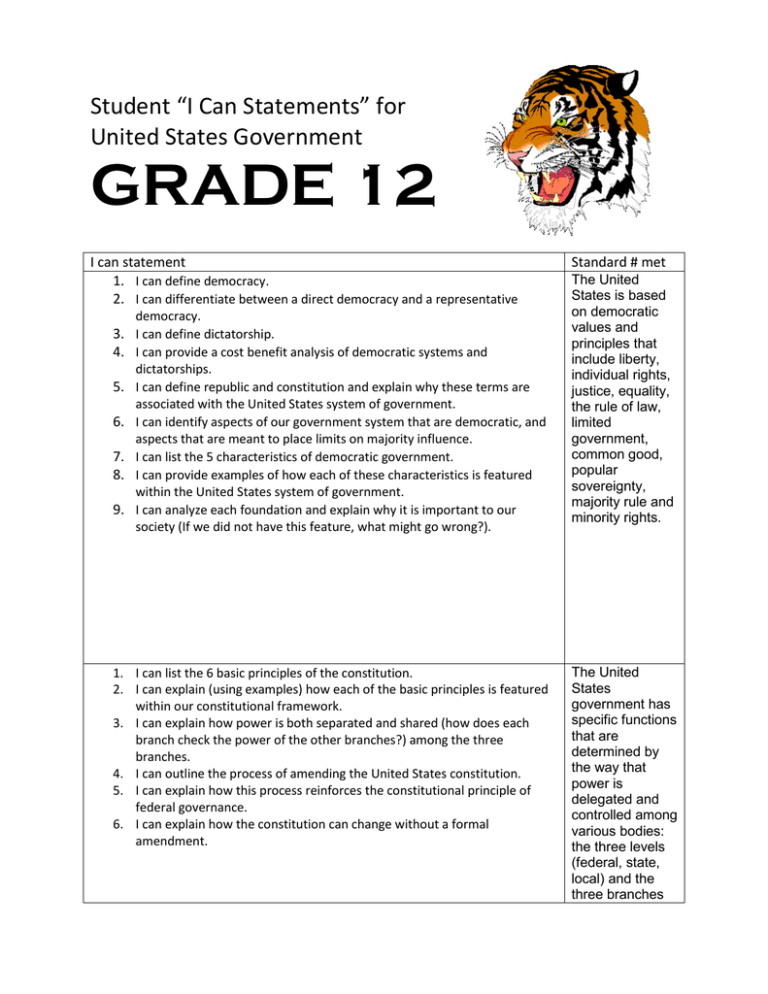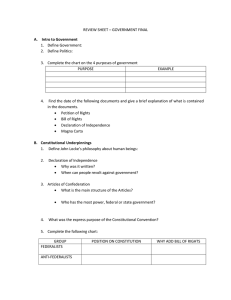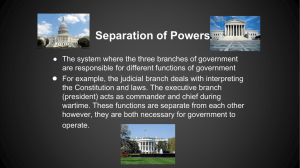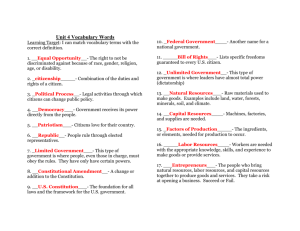Government - Marshall Public Schools
advertisement

Student “I Can Statements” for United States Government GRADE 12 I can statement 1. I can define democracy. 2. I can differentiate between a direct democracy and a representative 3. 4. 5. 6. 7. 8. 9. democracy. I can define dictatorship. I can provide a cost benefit analysis of democratic systems and dictatorships. I can define republic and constitution and explain why these terms are associated with the United States system of government. I can identify aspects of our government system that are democratic, and aspects that are meant to place limits on majority influence. I can list the 5 characteristics of democratic government. I can provide examples of how each of these characteristics is featured within the United States system of government. I can analyze each foundation and explain why it is important to our society (If we did not have this feature, what might go wrong?). 1. I can list the 6 basic principles of the constitution. 2. I can explain (using examples) how each of the basic principles is featured within our constitutional framework. 3. I can explain how power is both separated and shared (how does each branch check the power of the other branches?) among the three branches. 4. I can outline the process of amending the United States constitution. 5. I can explain how this process reinforces the constitutional principle of federal governance. 6. I can explain how the constitution can change without a formal amendment. Standard # met The United States is based on democratic values and principles that include liberty, individual rights, justice, equality, the rule of law, limited government, common good, popular sovereignty, majority rule and minority rights. The United States government has specific functions that are determined by the way that power is delegated and controlled among various bodies: the three levels (federal, state, local) and the three branches (legislative, executive, judicial) of government. 1. I can identify what makes a government unitary, confederate or federal. 2. I can describe the arguments of both the Federalists and Anti-Federalists regarding the ratification of the constitution. 3. I can identify the source of the national government’s powers. 4. I can define enumerated power, and show you the source of the national governments enumerated powers in the constitution. 5. I can define implied power, and show you the source of the national governments implied powers in the constitution. 6. I can identify the source of state power. 7. I can define reserved power, and show you the source of the state’s reserved powers in the constitution. 8. I can provide examples of exclusive, concurrent and reserved powers. 9. I can outline the provisions of the supremacy clause. I can explain the impact of the supremacy clause regarding the balance of power between the states and the national government. 10. I can outline the provisions of the Full Faith and Credit Clause. I can explain the impact of the Full Faith and Credit Clause on the legal relationship between the states. 1. I can draw and correctly label the political chart. I am able to place myself, others, politicians, public figures and political parties on the political chart based on their stated views regarding social and economic issues. 2. I can describe the basic functions (tasks) of political parties. 3. I can explain why we have only two major parties. 4. I can explain how federalism has led to the decentralization of our major political parties. 5. I can identify the major demographic features of each major party (Who supports them?). 6. I can identify differences between political parties and interest groups. 7. I can describe various methods that interest groups can use to lobby government. 8. I can describe the role of money in politics. I am able to identify ways in which money impacts the political process. 9. I can explain the Madisonian Dilemma regarding interest groups and our political process. I can explain how interest groups connect people to government and make our political system more representative of the various interests of the people. The United States government has specific functions that are determined by the way that power is delegated and controlled among various bodies: the three levels (federal, state, local) and the three branches (legislative, executive, judicial) of government. Public policy is shaped by governmental and nongovernmental institutions and political processes. I can explain why some interest groups can have an oversized role/say in shaping, passing or defeating legislative proposals, leading to a less majoritarian government. 1. I can provide the constitutional basis for free speech. I can explain, using Supreme Court cases as a reference, the degree to which free speech is protected 2. I can provide the constitutional basis for freedom of the press. I can explain, using Supreme Court cases as a reference, the degree to which freedom of the press is protected under the 1st amendment. 3. I can outline the constitutional basis for “freedom of religion”. I can explain, using Supreme Court cases as a reference, what the establishment clause prevents government from doing. I can explain, using Supreme Court cases as a reference, what the free exercise clause prevents government from doing. 4. I can provide the constitutional basis for freedom of association. I can explain, using Supreme Court cases as a reference, to what degree freedom of association is protected by the 1st amendment. 5. I can describe the rights of citizens at all phases of the legal process. 6. I can identify the basis of the constitutional requirement for equality under the law. I can explain, using Supreme Court cases as a reference, to what degree we are guaranteed equal protection under the law. Individuals in a republic have rights, duties and responsibilities.






